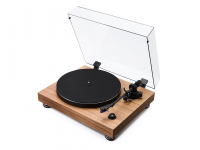
Getting to grips with High-End Headphones
As a high-end headphone user myself, I spend a lot of my time expounding upon the benefits of a good set of ‘cans’ to anyone who’ll listen (and a fair few who won’t).
In recent years, it’s fair to say that headphones, as a medium for delivering your favourite tunes, have taken a step into a whole new dimension. High-end headphones have been around for almost as long as speaker based systems and prices have always been wide and varied. Now, more than ever, manufacturers are creating products at the cutting edge. Happily for the consumer, competition means that prices are sharper than ever too!
We are going to cast an eye over two of the oldest and most respected headphone brands in the world. As the manufacturers would have us believe, these are two of their finest works to date.
German manufacturer Beyerdynamic started up in 1924, under the catchy moniker of Elektrotechnische Fabrik Eugen Beyer and (importantly for yours truly, a Scouse reviewer) provided the microphones used by The Beatles on their gigging return to Hamburg in 1966.
Sennheiser (also German) came into being in 1945. These days they employ over 2,400 people worldwide. Sennheiser are a leading studio microphone manufacturer, much like their compatriots. Their wares can be found in recording studios across the globe.
The headphones in question are the Beyerdynamic T90‘s, and the Sennheiser HD700‘s. Given the extraordinary history of both brands, it’s not hard to imagine that at this level, the products are exemplary. Falling perfectly inline with classic hi-fi rules, your preference on an overall idea and taste for sound will dictate which of these two sets are the right one for you. Let us delve!..
The T90’s are proudly marketed as part of Beyer’s Tesla line of products, named after the unit of measurement for Magnetic Flux Density. This isn’t just pseudo-scientific branding though by any means – the T90 uses one of the most powerful magnets in production headphones today. With such a powerful magnet, the voice coil is able to be much smaller and lighter, and also helps with sensitivity and ease of drive. In practise, I found the T90 to offer a very detailed sound, but not in a particularly analytical way. Bass was lush, weighty and warm, as was the treble. That’s not to say that the sound was muddy: high frequencies were not lost. In fact, nothing felt like it was missing from the presentation and there was no stridency to the top end. Listening for long periods was a joy and the involvement invoked by their staggering musicality was brilliant.
Build quality was superb (to be expected) with a lovely, soft set of velour ear pads and a circular cup that gave good coverage around the whole ear. The headband is comfy over long periods. These are definitely a traditional-looking headphone: I think that the design is fairly representative of the sound itself. Relaxed, detailed and very classy.
The Sennheiser HD700’s are their second-to-top tier headphone and are only beaten in the range by the mighty (and nearly twice the price) HD800. Owning a set myself, I have a huge soft spot for the HD700. They are futuristic looking, with a composite frame housing their own drivers (unique to this particular model). The ear cups are ergonomically designed to give the widest and most comfortable fit possible; they really do the job on even the longest of sessions, with almost no ache to the side of the head.
The cans are as open-back as it is possible to be. With the music switched off there is almost no isolation from outside at all: they do leak a lot of sound. All of this, however, is in the interest of gaining the clearest and most detailed sound. The separation of instruments from these headphones is immense. There is an almost supernatural, quite spooky degree of sound depth and width. If the Beyer’s are a full and slightly warm sound, these are an engineers dream. The top end sparkles, offering a moderately dry, crisp treble. Leading edge and punch is exceptional and cymbals have never sounded so good. That’s not to say that the bass isn’t worth shouting about either. It’s definitely on the leaner side of the spectrum, not having the same bloom as the T90, but it stops and starts on a knife edge, and it never feels underwhelming.
There is a huge amount to recommend for either of these headphones. They are a shining example of what can be done when engineers are allowed to work almost without consideration of cost.
It’s still a very subjective thing and your mileage may vary – but if you are interested in going to the next level with your at-home listening, then I implore you to give these a try. Ring your local store today to arrange a demonstration. Remember to bring the tunes!
Shop our full range of Headphones at Richer Sounds.
Author – Chris, Liverpool store





